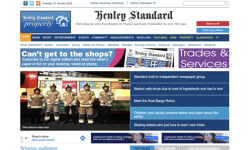I was there at the Apple store on Regent Street on 28th May, queuing up with my complimentary bottle of Evian, waiting to fork out £529 for an iPad. Professional necessity, you realise, rather than because I was itching to run my hands over its lovely contours and large, come-hither display...
I’ve now had several weeks of downloading and testing Apps (well, when I’ve been able to prise it away from my wife, 6 year old and even my 2 year old). And I’ve been surprised at how it has affected my media consumption. But more of that later.
The arrival – and apparent success - of the iPad is a very big deal for the world of publishing. The weight of expectation is that tablet computing can revive business models ripped apart by the web, falling circulations and dwindling CPM advertising yields.
But publishers now also face a bewildering set of business choices. We had learnt to accept – and in many cases to love - the dual-world of print and web; developing know-how for running our web and ezine ‘platforms’ alongside our print production expertise. Now, in short shift, the platform-channels for delivering our content have proliferated.
Things are moving extremely quickly. Don’t expect the iPad to monopolise the tablet category for long, with devices based on Google’s Android set to launch later this year, and Microsoft not far behind. It is interesting to note that, according to comScore, Android has already overtaken Apple at second place in the US smartphone market (Blackberry is top at 36%, with Android at 28% and Apple at 21%). Apple’s early lead in the UK is also diminishing, with Android now responsible for 20% of new smartphone sales – although stats from Admob for April still give Apple 4m UK devices to Android’s 0.4m. In terms of App stores, although all the major handset manufacturers have now launched their own, Apple and Android dominate (see table below).
| Number of Apps | Device Maker | New Apps/month |
| 150,998 | Apple | 13,865 |
| 19,897 | Android (Google) | 3,005 |
| 4,756 | Blackberry (RIM) | 501 |
| 6,118 | Ovi (Nokia) | 734 |
| 693 | Windows | n/a |
Control of the smartphone and tablet markets will involve an epic country-by-country struggle lasting three or four years, between the technology titans and their respective ecosystems of hardware, telecom and software partners.
The largest (B2C) publishers are not waiting to watch the outcome. They are investing heavily in the development of Apps across multiple platforms, thinking about production workflows, and busily whipping up enthusiasm amongst media buyers and brands. But just because of the hype, don’t get hoodwinked into thinking that these companies know the outcome. They are placing big bets that their traditional print-models will migrate to tablet-based Apps, with a gradual introduction of multimedia and interactivity. This may prove to be on-the-money. On the other hand, it may be leading them in entirely the wrong direction, compounding the disaster ahead.
So what are the rest of us supposed to do? Sit back and wait until it’s clearer which platforms will be dominant, hoping the big boys establish viable business models? Hmmm... that sounds a bit like the timid approach taken by the industry to the internet’s arrival fifteen years ago, which opened the doors for a new pantheon of innovative, web-embracing media brands. Or, at the other extreme, should we be pioneering Apps for every platform out there, pushing the envelope with original content and innovative solutions, and putting ourselves in pole position to benefit once the dust finally settles? Ouch, sounds expensive, just when we’re worrying again about a double-dip recession.
You can break down the ‘To App or not to App?’ question as follows:
1. Are Apps here to stay?
The early evidence from iPad reviews (and personal experience) is that web-browsing is its biggest beneficiary, even more so than App consumption. Smartphones including the iPhone relied heavily on Apps because the web-browsing experience was so poor. The iPad’s large screen and high resolution changes the balance. This is being accelerated by the web’s switch-over to html5 video-players, so reducing the importance of Flash to video-consumption on the web (Apple is winning in its turf warfare with Adobe, the maker of Flash). With more and more websites also introducing versions specifically for mobile screens, the gap between web and App is narrowing even for smartphones, let alone tablets.
Mobile web-browsing is still only 2% of web-traffic, but that’s 150% more than one year ago, and it’s set to soar, with Gartner predicting that it will exceed desktop web-browsing by 2015. So a first piece of advice is, if you haven’t already got a mobile-friendly version of your website, do so now. It’s easier than ever to implement, and without one, the first mobile-visit made to your site is likely to be the last...
But Apps still offer consumers two crucial advantages over web-browsing - accessibility and geo-awareness. The WiFi/3G infrastructure underpinning mobile browsing is patchy, and non-existent if you go through a tunnel or get on a plane. Apps don’t suffer from this constraint, as content (or content updates) are downloaded to the device, giving consumers guaranteed access with no waiting times. Geo-awareness is built into smartphones and tablets, but not into the web’s architecture (at least not for a while). Mapping features on websites rely on the consumer typing in their current location. A whole range of top-ranking Apps offer location-based services; eg Rightmove and Toptable.
The conclusion is that Apps are going to represent an increasing share of media consumption, at least for the next few years until html5 protocols are fully agreed and rolled-out, relative to web-browsing.
2. If I do need an App, which platforms should I consider?
This is a fairly easy one. For almost all publishers, the starting point is the Apple App store. The stats presented earlier say it all.
You don’t need to choose between iPhone and iPad, as universal Apps can be written, which detect the user’s device and load up appropriately. It is more work than simply developing for either device, but only of the order of 30-40 hours extra for an average App, even allowing for some creativity of layout (ie rather than the iPad version purely being a ‘blow up’ of the iPhone version).
If you can achieve success on the Apple App store, then think about Android, and, for B2B, Blackberry. For the time being, nobody else really matters. Given that Apps need to be re-written for each platform, being present across multiple platforms doesn’t come cheap.
3. Will Apps deliver ROI?
This is a loaded question – how much does your App cost to develop, how are you monetizing it, what are your objectives, from immediate profit contribution to long-term brand-awareness?
Apps come in all sorts of varieties. For time-sensitive publishing, the simplest (and cheapest) type of App is an RSS-style update, as successfully rolled out by blogs such as Engadget and the Onion, and by regionals including the Manchester Evening News. These are often not dissimilar to the mobile version of the corresponding website. They are generally free, with many using exclusive-sponsorship to generate revenue. More complex, often paid, variants of this approach have been taken by newspapers, including the Guardian, Daily Telegraph, Financial Times and New York Times. These split news items into categories, which can be tailored so that only selected categories are updated. You can also save favourites, share news items via email and social media, and send comments.
The FT has an excellent iPad-only App, securing sponsorship from watchmaker Hublot to give readers “free access until July 31st”. Graham McFadyen, global head of membership marketing at the FT, tells InPublishing that App downloads are now a major source of new digital subscriptions, and he’s now focused on converting the huge numbers of iPad app downloads to subscribers once the sponsorship period ends (the FT reported 130,000 downloads in just two weeks after its launch).
After launching in December, the Guardian broke through the 100k downloads barrier (at a £2.39 price tag, less Apple’s 30% commission) by 23rd February, and has been surveying users on how they would view a subscription-based version. Ironically, given the Guardian’s stance on the whole paywall debate, I have given up using the Guardian App on my iPad, reverting to the website, which has more content and looks better.
You may not primarily be a news publisher, but you may well use an ezine in order to deliver lead-generation for premium content, or on a sponsorship-basis. Ezines can be fairly easily converted into Apps, offering a new channel to offset declining email opening and click-through rates. Just think carefully about your use of push-notifications, to avoid appearing like an App-spammer.
Magazine apps
For magazines and other periodical publishers, it’s all about whether the iPad can prove that tablets are viable successors to print. Conde Nast’s GQ experiment on the iPhone, while beautifully executed, only went to show that a smartphone-screen cannot hope to replicate the experience of the glossy magazine.
I worry that many magazines will take the cheap-and-lazy approach of extending existing supplier relationships. Simply digitizing page-images of a print magazine means no text search or annotation, let alone interactivity or multimedia features. Using these Apps means having to zoom in to every column on every page in order to simply read the words, even on an iPad. The user experience is awful, and if enough publishers go down this route, we risk collectively killing off consumer interest.
To their credit, Wired went to the other extreme with their iPad App, which at $4.99 is currently at #27 on the iPad top-grossing App list. This delivers real artistic beauty, as well as a genuine attempt to deliver interactivity and multimedia. But these are early days, and there is certainly frothy excitement about some fairly mediocre and superfluous functionality. The reality is that even the iPad’s screen size is only half that of a paper magazine. So formats and text designed for paper don’t look as good. Another problem is that full-page adverts on a tablet feel more akin to pop-ups on a PC, undermining the reader experience, compared with adding “weight” to the paper product. Finally, there’s a long way to go to make digital magazines practical – the aforementioned Wired iPad App is a hefty 500mb. It takes about an hour to download over a standard broadband connection, and a year’s subscription would consume the entire free space on my iPad. This is not a scalable model.
The key question is whether successful magazine Apps can be generated by simply converting the existing print issue to a tablet format, adding interactive and multimedia bells and whistles. The Wired iPad app was developed in partnership with Adobe, which is now preparing to launch its Digital Publishing Platform. Adobe hopes to extend its dominant InDesign franchise, promising to deliver Apps (for all the major platforms) as an additional output of the existing print production process. It sounds enticing, but I am sceptical that the artistic directors of print magazines will be able to deliver a digital revolution to leapfrog the web, with its social sharing, video, rich media advertising and defined standards. It’s controversial, but it may be that our web-design teams should be handed control of the task of re-inventing the magazine format for the App age.
I’ve attempted a whirlwind discourse on what is a huge and constantly-moving topic that looms large for all publishers. I would strongly advise giving yourself the goal of launching an App (if you haven’t already done so) before the end of the year. But treat it as much a part of the essential professional development of your staff as anything else. If you don’t build App know-how now, you risk withering away as surely as your print circulations.










